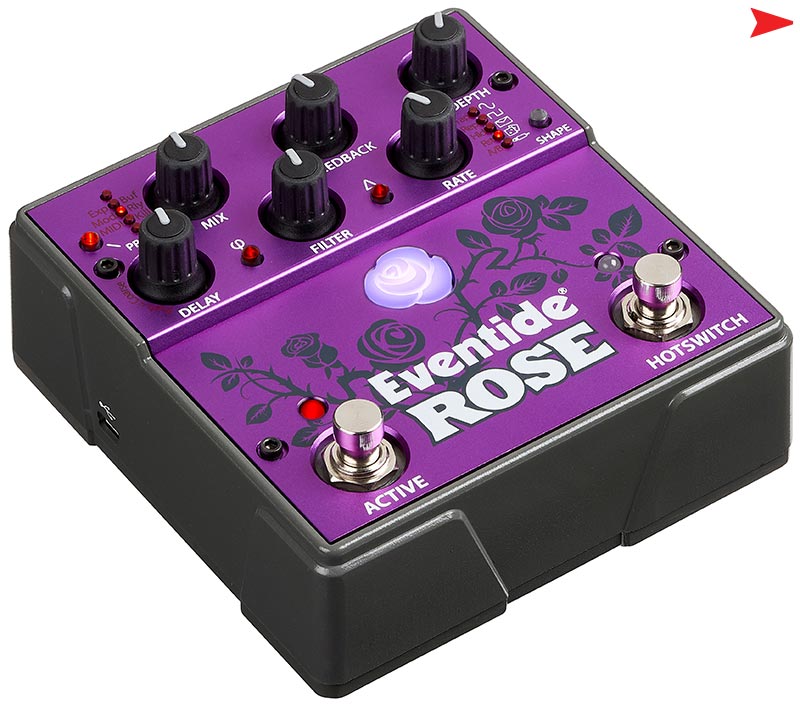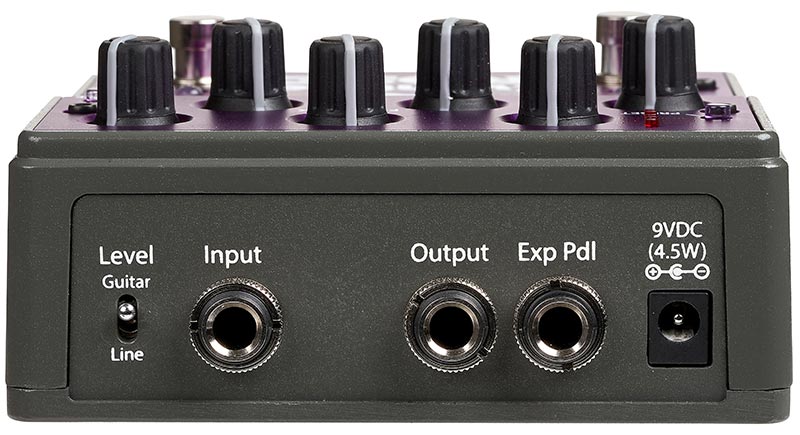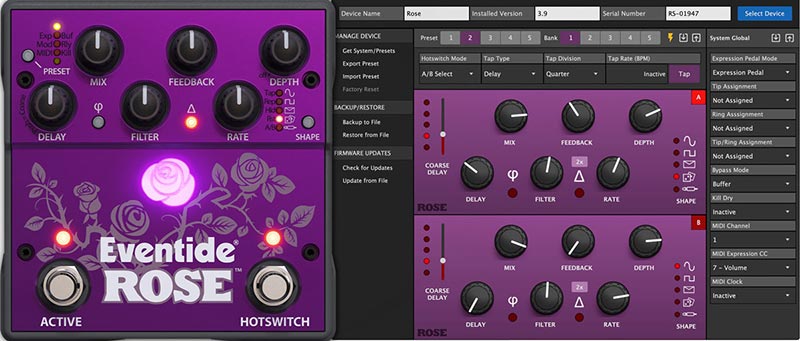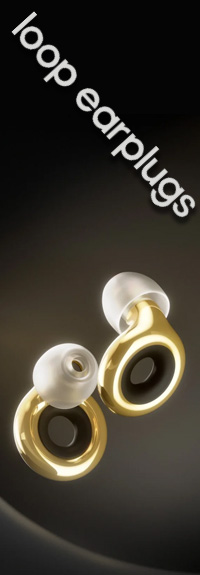Established in 1971, Eventide has been an industry-standard in the world of recording, post-production, and broadcast studios around the globe. Known for their high-end digital audio effect processors, Eventide made the move into guitar effect pedals in 2007, releasing the successful Factor series (Space, Time, Pitch, Mod). In 2013, Eventide struck gold once again with the release of the H9, which combined the entire family of the Space, Time, Pitch, and Mod Factors pedals, as well as their own exclusive H9 algorithms.
Building on the success of the H9, and the massive interest that guitar pedals as of late, Eventide has released four new pedals, The Rose, Blackhole, Micro Pitch, and the Ultra Tap. Out of the four pedals, the Rose, a hybrid digital / analog delay, is the only pedal that has not been present on any previous Eventide platform.

Thorn To Be Wild
Physically the Rose follows suit to all of Eventide’s most recent pedal templates, six knobs, four small buttons, two footswitches, and a handful of tiny LED lights. This might make you think the Rose is similar to Eventide’s other offerings, in addition to every other delay pedal out there, but the multicolored, pulsating rose logo is the first indication that Dorothy picked up Toto and left Kansas, permanently.
Let’s talk about the core of the Rose, and of course, we’re talking about the delay. The delay is based on a variable digital clock that can be swept over a very impressive range from 10 microseconds to 10 seconds. However, by activating the Delta mode button, you can multiply the delay time by lowering the sample rates in increments of 2x, 3x, 4x, and 5x making it possible to achieve up to 50 seconds of delay time. For a delay pedal, that’s massive!

The Delta multiplier can create so many different sounds, textures, and evolving loops. For example, while playing in the Delta multiplier mode, then shutting it off, you’re able to create shifts in pitch. Thus, if the Delta mode is on 2x and you press the Delta button off, whatever you were playing goes up one octave, 3x one octave and a fifth, 4x two octaves, and 5x two octaves and a third. Creating these high pitch cascading lines.
Another component that makes this pedal so unique is the Phi button. The Phi button produces some of the best reverse delays that I have ever had the pleasure of playing. In fact, I have always been on a quest for that perfect backward sound in a pedal, especially when performing. I can honestly say that in conjunction with the analog filter, mixer, feedback, and the modulation portion of this pedal, I have dialed in some of the most satisfying and inspiring sounds to date.
The Phi mode also plays an important role when the delays are short and below 20 ms. In comb filter mode, turning the delay knob inverts the phase delay line, and along with the feedback knob, you can dial in some mild to wild sounding chorus, flanger, vibrato, auto-wah, and ring modulator tones that sound great, all while remaining true to the essence of what the Rose has to offer.

The easiest way for electronic musicians to get their music onto Spotify, Apple Music, iTunes, Amazon Music, Tidal, Instagram, Facebook, TikTok, Pandora, Twitch & much more! Click the banner above or the Go Button to save 7% off of your signup! GO!
Analog Filter, Feedback & Mixer
The Rose features analog circuitry for the filter, feedback, and mixer knobs. The filter lets you dial in delay sounds ranging from pristine to some really warm, soothing tape-like effects. From the very first moment, you twist the filter knob and hear its effect on the overall sound, you immediately know, it’s a first-rate filter. Using the filter, feedback and mixer make it easy to dial in some really sweet sounds.
The modulation section is another component, that makes the Rose stand out from the crowd. The rate and depth knobs control the modulation, and the shape button provides a selection of five modulation sources: sine wave, square wave, envelope, random, and external. They all collectively perform and sound exceptional.

The rear panel has a single TS jack input that can be switched to accept line or instrument level inputs, and from there the dry signal path is all-analog. There’s a single output (The Rose is a mono pedal), and there’s another jack to which you can hook up a footswitch or expression pedal. Power comes from the included adaptor, and a USB port utilized for both firmware upgrades and MIDI control. The top panel Hotswitch footswitch can be assigned for tap tempo, infinite repeat, A/B switching, LFO hold or LFO reset functions, and bypass can be set to relay, buffered, or input kill settings.
➤ Eventide Rose Features:
- Analog dry path with analog Mix, Filter, and Feedback
- Comes with 25 presets (5 banks with 5 presets each)
- Standard delay times from 10 sec to 10 sec
- Modulation sweep from 1/2 to 2x the standard delay time, simultaneously modulating pitch across a full octave +/-
- Selectable modulation source: Sine / Square / Random / Envelope / External (CV)
- Tap Division selection (quarter, eighth, dotted eighth, triplet)
- MIDI Tap Tempo & Clock Receive
- Reverse delay function for backward delays
- Invert function flips the phase of the delayed signal
- Delay Multiply (2X, 3X, 4X, 5X) for delays up to 50 sec
- Assignable Hotswitch: Tap Tempo / Infinite Repeat / A/B switching / LFO Hold / LFO Reset
- Input Level Select Switch: Line / Instrument
- TRS/TS Input for an expression pedal, auxiliary Switch, and MIDI
- Selectable Bypass: Relay / Buffered / Input Kill
- USB for use with Eventide Device Manager (manage presets, settings, MIDI, and more)

Every Rose Has Its Thorn
Unfortunately, the Rose is not perfect. For a guitar pedal, there is a rather significant learning curve to gain a full understanding of the control combinations. Worse, if you’re away from the pedal for an extended period of time, those combinations are easily forgettable and must be relearned. It is not impossible, just annoying because there is a lot to remember, and for some that might be a dealbreaker. For instance, I wanted to change the tap division of the delay from a quarter note to a dotted eighth note. While I’ve spent considerable time with the Rose, I could not remember the combination required to get into that mode to make the change. I still have to grab the quick reference guide or watch one of the videos on the Eventide website to refresh my memory. I would be a little frustrated if this happened in a live situation, on stage.
Who Should Get The Rose?
For anyone who is into, Ambient, Cinematic, EDM, Experimental, Post -Rock, Shoegaze, or any modern sounding music, this is a fantastic pedal. Anyone who is striving to find new atmospheric sounds, or for the times you need that extra bit of mojo to send your sound over the edge, this would be a great choice. Even though it can do most cookie-cutter delay sounds, this pedal blossoms when you use it to what it was made to do, manipulating sound and time.
Eventide Rose Demo
Conclusion
Eventide has created a powerhouse of a delay that truly stands apart from other competitors in their crowded field, and that is no easy feat. The Eventide Device Manager allows you to fully customize your five banks of five presets, perform software updates, and more, which is a huge added value. The Rose sounds gorgeous and offers endless sonic possibilities. Initially, I was intrigued by the whopping delay time range of 10ms – 50 seconds. However, once I delved deeper, I discovered many of the Rose’s hidden talents, including the reverse delay, which sounds amazing. The sounds that you can achieve range from complex, subtle, warm, atmospheric to expansive and world-building. It can motivate you musically to explore ideas that you would not have otherwise considered. Eventide has Rose to the occasion. Recommended!
Rating: 89%
Cheers:
+ 10 microseconds to 50 seconds of delay
+ Phi and Delta Modes
+ Quick reference guide and the 21 instructional videos on the website
+ Build Quality
+ Flexible
+ Sound Quality
+ Eventide Device Manager
+ Connectivity
Jeers:
– Learning Curve
– Hard to remember control combinations
– Manual
– Mono

Eventide’s Rose cost $349 and is available now.
The Future: If Eventide were inclined to update the pedal to version 2.0, we’d like to see additional modulation waves available to download from Eventide Device Manager utility. Another external input would also be beneficial, so you could simultaneously connect both an expression pedal and an extra three button TRS Auxiliary switch. With such expansive and wonderful tone, we’d obviously love to see a stereo output with a switchable Mono/Stereo functionality like the Eventide Ultra Tap. An independent mini-toggle switch for the tap division would also add value. Finally, if there was a way to simplify the operation so you wouldn’t have to go manual diving every time you used the pedal would be a huge win and gain more fans.








